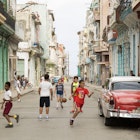

During the lean years of the 1990s, the Cubans were ecologists by necessity. But as times changed, so did the public zeitgeist. As the country faces the twin threats of rising tourist numbers and looming climate change, 10% of its land is now under environmental protection, and Cuba's eco-credentials are proving far from hollow.
Head off the beaten tourist trail to any of these pockets of unspoiled Cuban nature, and you'll see what we mean.
Isla de la Juventud
In Cuba all underwater roads lead to Punta Francés, a national marine park off the coast of Isla de la Juventud where the protected coral, water clarity and stunning caves turn snorkelers into divers and divers into budding marine scientists. Boat transfers from the Marina Siguanea take about an hour and deliver you to a gorgeous stretch of white-sand beach (complete with rustic restaurant) from which most of the main dive sites are easily accessible. The cream of the crop are Cueva Azul (advanced) and Pared de Coral Negro (intermediate), where you’ll see abundant fish including tarpon, barracuda, groupers, snooks and angelfish – along with the odd sea turtle.

Península de Zapata
The Caribbean’s largest swamp is a nirvana for fishermen, bird-watchers, tour-circuit escapees and weekend eco-warriors in search of Cuba’s only dangerous animal, the snappy Crocodylus rhombifer (Cuban crocodile). Most of the peninsula is included in Gran Parque Natural Montemar, a Unesco Biosphere Reserve since 2001. Despite being one of Cuba’s largest municipalities, Península de Zapata is one of its wildest and least inhabited.
Baracoa
Isolated for centuries, the town of Baracoa sits behind the jungle-like curtain of the Cuchillas de Toa, a mini-Amazon of extraordinary endemism and a thousand different shades of green that beckons like a Cuban Shangri-La. Designated a Unesco Biosphere Reserve in 1987, the 2083-sq-km area incorporates the Alejandro de Humboldt World Heritage Site and contains the largest rainforest in Cuba. Keep an eye out for all the unique species frolicking among the foliage.

Pico Turquino
In a country where the right to roam isn’t quite as hallowed as the right to free health care and education, the trek up Cuba’s highest mountain, Pico Turquino - named for the turquoise hue that colors its steep upper slopes - is a rare privilege. Best tackled as a through trek from the Santo Domingo side, the rugged, two- to three-day grind up Turquino starts from Alto del Naranjo near La Plata and ends at Las Cuevas on the Caribbean coast. Guides are mandatory; ask yours to take you on a side trip to Fidel’s wartime jungle HQ on the way up.
Pinar del Río Province
Successful environmental projects were rare in the 1960s, which makes the achievements of Cuba’s original 'new model village,' Las Terrazas (founded in 1968), all the more remarkable. Come to Pinar del Río province and meet the artisans and artists who live here, check out Cuba's longest surviving coffee plantations, and go bird-watching in the verdant surroundings.
This article was refreshed in July 2017.
Explore related stories





 ActivitiesThe top 8 hikes in Cuba, from forested trails and historical hideouts
ActivitiesThe top 8 hikes in Cuba, from forested trails and historical hideoutsFeb 15, 2022 • 8 min read


